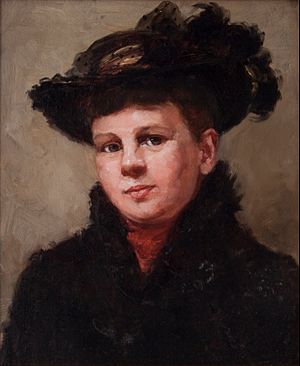Clara Chipman Newton facts for kids
Quick facts for kids
Clara Chipman Newton
|
|
|---|---|

Clara Chipman Newton as painted by Mary Louise McLaughlin
|
|
| Born | October 26, 1848 Delphos, Ohio, U.S.
|
| Died | December 8, 1936 Cincinnati, Ohio, U.S.
|
| Resting place | Spring Grove Cemetery |
| Nationality | American |
| Known for | Painting |
Clara Chipman Newton (born October 26, 1848 – died December 8, 1936) was an American artist. She was famous for painting beautiful designs on porcelain and china.
Contents
Clara's Early Life and Learning
Clara was born in Delphos, Ohio. Her family moved to Cincinnati, Ohio in 1852. She went to a private school for girls from 1863 to 1865. When her father passed away in 1871, Clara decided to stay in Ohio. Her stepmother moved to Denver, Colorado.
In the early 1870s, Clara studied at the School of Design of the University of Cincinnati. She learned wood-carving and china painting there. Her teacher was Benn Pitman. People who knew Clara said she had an amazing memory. She was also good at business and had a unique way of writing.
Clara's Art Career and Achievements
Clara showed her painted china at a big event in 1876. It was called the Centennial Exposition in Philadelphia. In 1879, she helped start the Cincinnati Pottery Club. She became its secretary. Her close friend, Mary Louise McLaughlin, was also a founding member.
For over ten years, Clara worked at the Rookwood Pottery. This famous pottery company started in 1880. Clara was a china decorator and helped with many tasks. She was even called the secretary of the company. She helped oversee how the pottery was decorated and glazed. Starting in 1881, she taught classes at Rookwood's new pottery school. Clara was a very important part of two groups. These groups helped create the American art pottery movement.
Organizing the World's Fair Exhibit
In 1893, a huge event called the World's Columbian Exposition happened in Chicago. Clara played a big role in setting up the Cincinnati Room there. This room was in the Woman's Building. Clara was in charge of arranging about 280 objects for the exhibit. These items included pottery, paintings, sculptures, and needlework. Many of them were made by her friend and mentor, Mary Louise McLaughlin.
Teaching and Supporting Women Artists
Clara did not have a lot of money on her own. So, she opened her own art studio in Cincinnati in 1885. Around the same time, she also taught part-time at the Thane Miller School. In the early 1900s, Clara moved to Glendale, Ohio. There, she led the art department at the Glendale Female Seminary. Throughout her career, she taught many art forms. These included china painting, watercolor, oil painting, and relief modeling.
Clara always supported new art forms. She also championed what she called "women's work." She was a founding member and secretary of the Cincinnati Woman's Club. This club has been active since 1894.
Later Works and Legacy
In 1906, Clara created watercolor decorations for a book. It was an edition of Oscar Wilde's Poems in Prose. Her designs included beautiful capital letters and flowing patterns. These were in the Art Nouveau style. This kind of decoration was popular in books for collectors.
You can see an example of her porcelain painting work today. It is in the Metropolitan Museum of Art in New York City. Her personal papers were given to the Cincinnati Historical Society after she passed away. Clara Chipman Newton died on December 8, 1936, when she was 88 years old.
See also
 In Spanish: Clara Chipman Newton para niños
In Spanish: Clara Chipman Newton para niños


